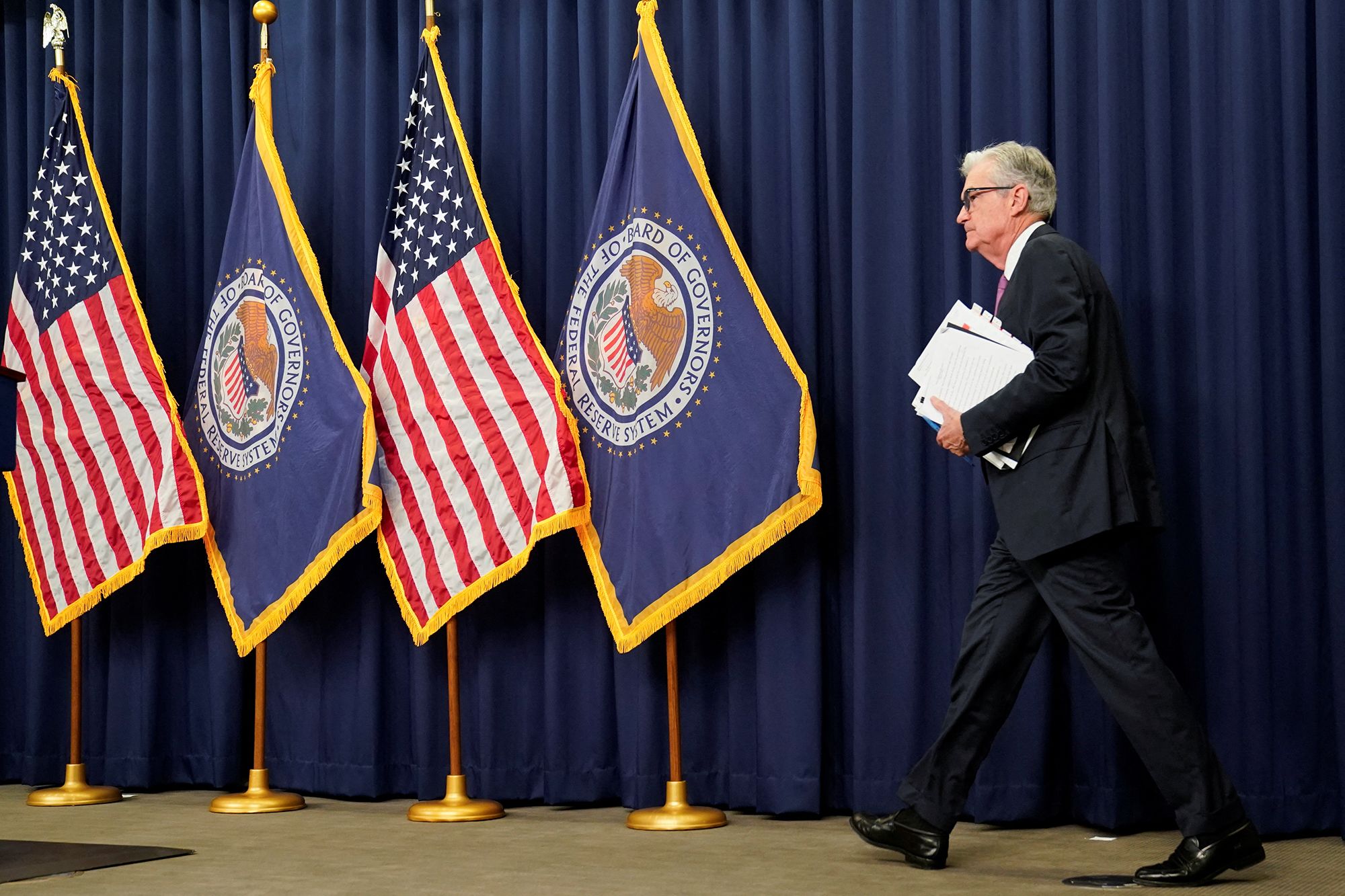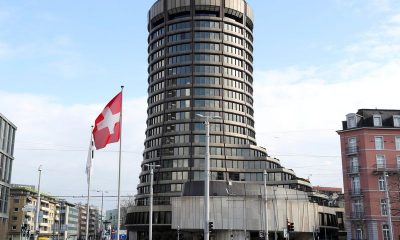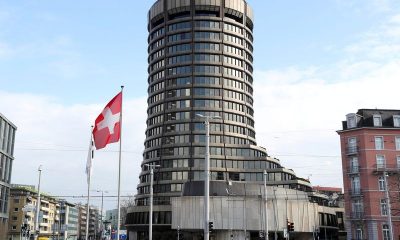Economy
Fed leaves rates unchanged, sees two small hikes by end of 2023

The Federal Reserve left interest rates unchanged on Wednesday but signaled in new projections that borrowing costs may still need to rise by as much as half of a percentage point by the end of this year, as the U.S. central bank reacted to a stronger-than-expected economy and a slower decline in inflation.
In a press conference at the end of the central bank’s latest policy meeting, Fed Chair Jerome Powell described U.S. growth and the job market as holding up better than expected under the weight of the aggressive monetary policy tightening of the past year – likely lengthening the Fed’s fight to lower inflation but also letting it proceed with less economic damage.
The pause was out of caution, Powell said, to allow the Fed to gather more information before determining if rates do need to rise again, with the pace of its moves now less important than finding a proper endpoint that slows price increases while minimizing any rise in unemployment.
After a year in which many economists and analysts argued recession was imminent and the economy about to crack, under the Fed’s latest quarterly projections “growth estimates moved up a bit, unemployment estimates moved down a bit, inflation estimates moved up,” Powell said.
Taken together, the data suggested “more restraint will be necessary than we thought,” Powell said of new projections which showed a uniform shift higher in policymakers’ interest rate outlook for the year. Nine of 18 officials see the benchmark overnight interest rate moving up another half of a percentage point beyond the current 5.00%-5.25% range, while three others feel it needs to go even higher.
But Powell also said he felt that the pieces of the inflation puzzle were beginning to fall into place, with the Fed focused on “getting the policy right” as it contemplates what may be its final rate increases before declining inflation allows possible rate cuts next year.
“The conditions we need to see… to get inflation down are coming into place,” Powell told reporters, including below-trend growth, a somewhat weaker labor market, and improving supply chains. “But the process of that actually working on inflation is going to take some time.”
It was a subtly optimistic message that tempered otherwise hawkish projections that see the policy rate rising higher than market participants anticipated.
Subadra Rajappa, head of U.S. rates strategy at Societe Generale, said she thought that was no mistake, with the Fed now keeping its options open in case further rate increases are needed, but not committed if inflation does decline faster than anticipated.
“The ‘dots’ are hawkish, but he did a good job of telling markets not to see it as such,” she said.
In fact, investors in contracts tied to the Fed’s policy rate see the central bank delivering only one quarter-percentage-point increase by the end of the year. They see about a 65% chance of a rate hike next month, up only slightly from before this week’s meeting.
‘LIVE MEETING’
Though Powell repeated the Fed’s standard warning about “upside” risks to inflation, the decision to hold steady at this time was also an effort to try to ease the pace of price increases “with the minimum damage” to the job market. The new projections showed the unemployment rate rising by the end of 2023 to 4.1% from the current 3.7%, but that is a significantly smaller increase than the 4.6% jobless rate officials projected in March.
“Holding the target (interest rate) range steady at this meeting allows the committee to assess additional information and its implications for monetary policy” before taking another step, the central bank’s rate-setting Federal Open Market Committee (FOMC) said in a unanimous policy statement at the end of its two-day meeting.
Powell said that even as officials have not decided what they will do with rates, the July 25-26 gathering is a “live meeting” which could bring another increase.
“This looks like a meeting where the Committee was split, everybody got something, and nobody got everything. A dovish decision, a hawkish statement, and very hawkish dots,” wrote economists at the analytics firm of Larry Meyer, a former Fed governor. “Ultimately … though Powell was vague on many points, we see his press conference as relatively dovish.”
U.S. stocks fell after the policy decision, but by the end of the day the Nasdaq Composite and the S&P 500 indexes had closed slightly higher. The Dow Jones Industrial Average was off 0.68%.
STRONGER ECONOMIC OUTLOOK
The Fed’s higher rate outlook coincides with an improved view of the economy and, consequently, slower progress in returning inflation to the central bank’s 2% target. It is currently more than double that.
Fed officials at the median more than doubled their outlook for 2023 economic growth to 1%, from 0.4% in the March projections.
The core Personal Consumption Expenditures Price Index is seen dropping from the current 4.7% to 3.9% by the end of 2023, compared to a 3.6% year-end rate seen in the March policymaker projections.
The policy decision on Wednesday snapped a string of 10 consecutive rate hikes delivered as the Fed responded to the worst outbreak of inflation in 40 years with a matching set of aggressive moves, including four outsized increases of three-quarters of a percentage point last year.
The central bank’s policy rate, which influences household and business borrowing costs throughout the economy, rose a full 5 percentage points from the onset of the tightening cycle in March 2022, reaching the highest level since just before the start of the 2007-2009 recession.
Economy
Russian central bank says it needs months to make sure CPI falling before rate cuts -RBC


© Reuters. Russian Central Bank Governor Elvira Nabiullina attends a news conference in Moscow, Russia June 14, 2019. REUTERS/Shamil Zhumatov/File Photo
MOSCOW (Reuters) – Russia’s central bank will need two to three months to make sure that inflation is steadily declining before taking any decision on interest rate cuts, the bank’s governor Elvira Nabiullina told RBC media on Sunday.
The central bank raised its key interest rate by 100 basis points to 16% earlier in December, hiking for the fifth consecutive meeting in response to stubborn inflation, and suggested that its tightening cycle was nearly over.
Nabiullina said it was not yet clear when exactly the regulator would start cutting rates, however.
“We really need to make sure that inflation is steadily decreasing, that these are not one-off factors that can affect the rate of price growth in a particular month,” she said.
Nabiullina said the bank was taking into account a wide range of indicators but primarily those that “characterize the stability of inflation”.
“This will take two or three months or more – it depends on how much the wide range of indicators that characterize sustainable inflation declines,” she said.
The bank will next convene to set its benchmark rate on Feb. 16.
The governor also said the bank should have started monetary policy tightening earlier than in July, when it embarked on the rate-hiking cycle.
Economy
China identifies second set of projects in $140 billion spending plan


© Reuters. FILE PHOTO: Workers walk past an under-construction area with completed office towers in the background, in Shenzhen’s Qianhai new district, Guangdong province, China August 25, 2023. REUTERS/David Kirton/File Photo
SHANGHAI (Reuters) – China’s top planning body said on Saturday it had identified a second batch of public investment projects, including flood control and disaster relief programmes, under a bond issuance and investment plan announced in October to boost the economy.
With the latest tranche, China has now earmarked more than 800 billion yuan of its 1 trillion yuan ($140 billion) in additional government bond issuance in the fourth quarter, as it focuses on fiscal steps to shore up the flagging economy.
The National Development and Reform Commission (NDRC) said in a statement on Saturday it had identified 9,600 projects with planned investment of more than 560 billion yuan.
China’s economy, the world’s second largest, is struggling to regain its footing post-COVID-19 as policymakers grapple with tepid consumer demand, weak exports, falling foreign investment and a deepening real estate crisis.
The 1 trillion yuan in additional bond issuance will widen China’s 2023 budget deficit ratio to around 3.8 percent from 3 percent, the state-run Xinhua news agency has said.
“Construction of the projects will improve China’s flood control system, emergency response mechanism and disaster relief capabilities, and better protect people’s lives and property, so it is very significant,” the NDRC said.
The agency said it will coordinate with other government bodies to make sure that funds are allocated speedily for investment and that high standards of quality are maintained in project construction.
($1 = 7.1315 renminbi)
Economy
Russian central bank says it needs months to make sure CPI falling before rate cuts -RBC


© Reuters. Russian Central Bank Governor Elvira Nabiullina attends a news conference in Moscow, Russia June 14, 2019. REUTERS/Shamil Zhumatov/File Photo
MOSCOW (Reuters) – Russia’s central bank will need two to three months to make sure that inflation is steadily declining before taking any decision on interest rate cuts, the bank’s governor Elvira Nabiullina told RBC media on Sunday.
The central bank raised its key interest rate by 100 basis points to 16% earlier in December, hiking for the fifth consecutive meeting in response to stubborn inflation, and suggested that its tightening cycle was nearly over.
Nabiullina said it was not yet clear when exactly the regulator would start cutting rates, however.
“We really need to make sure that inflation is steadily decreasing, that these are not one-off factors that can affect the rate of price growth in a particular month,” she said.
Nabiullina said the bank was taking into account a wide range of indicators but primarily those that “characterize the stability of inflation”.
“This will take two or three months or more – it depends on how much the wide range of indicators that characterize sustainable inflation declines,” she said.
The bank will next convene to set its benchmark rate on Feb. 16.
The governor also said the bank should have started monetary policy tightening earlier than in July, when it embarked on the rate-hiking cycle.

 Forex3 years ago
Forex3 years agoForex Today: the dollar is gaining strength amid gloomy sentiment at the start of the Fed’s week

 Forex3 years ago
Forex3 years agoUnbiased review of Pocket Option broker

 Forex3 years ago
Forex3 years agoDollar to pound sterling exchange rate today: Pound plummeted to its lowest since 1985

 Forex3 years ago
Forex3 years agoHow is the Australian dollar doing today?

 Cryptocurrency3 years ago
Cryptocurrency3 years agoWhat happened in the crypto market – current events today

 World3 years ago
World3 years agoWhy are modern video games an art form?

 Commodities3 years ago
Commodities3 years agoCopper continues to fall in price on expectations of lower demand in China

 Economy3 years ago
Economy3 years agoCrude oil tankers double in price due to EU anti-Russian sanctions



























